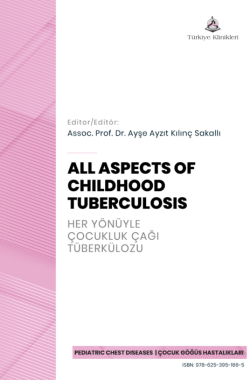Follow-Up and Adherence to Treatment of Tuberculosis in Children
Hakan YAZANa , Erkan ÇAKIRb
aBezmiâlem Vakıf University Faculty of Medicine, Department of Pediatric Chest Diseases, İstanbul, Türkiye
bİstinye University Faculty of Medicine, Department of Pediatric Chest Diseases, İstanbul, Türkiye
Yazan H, Çakır E. Follow-up and adherence to treatment of tuberculosis in children. In: Kılınç Sakallı AA, ed. All Aspects of Childhood Tuberculosis. 1st ed. Ankara: Türkiye Klinikleri; 2023. p.61-3.
ABSTRACT
Tuberculosis (TB) incidence has been decreasing globally and also in our country, but it still remains a significant public health issue. According to data from the World Health Organization (WHO) in 2018, there were approximately 1,100,000 pediatric TB cases worldwide, accounting for about 11% of the total TB burden. This percentage can vary, with developed countries having around 11% and developing countries going up to 40%. According to the Turkish Ministry of Health’s 2020 Tuberculosis Control Report, children aged 0-14 make up 5.1% of the 10,948 TB cases in Turkey. The diagnosis, differential diagnosis, treatment, and follow-up of childhood TB have some differences compared to adult TB. While reactivation TB is most common in adults, children more frequently present with primary TB, which has a lower bacterial load. Additionally, the difficulty in obtaining respiratory samples such as sputum in children results in lower rates of detecting the bacteria. Therefore, diagnosis in children often relies on clinical and radiological findings in addition to a history of contact with active TB cases. In addition to the challenges in diagnosing childhood TB, treatment adherence and follow-up are essential considerations. The absence of formulations of drugs specifically designed for children is one of the significant obstacles to maintaining treatment. In this section, we will discuss treatment adherence and follow-up for pediatric patients diagnosed with TB.
Keywords: Tuberculosis; pediatrics; therapy
Kaynak Göster
Referanslar
- WHO 2022 global report. [Link]
- Türkiye'de Verem Savaşı 2020 Raporu.
- Marais BJ. Tuberculosis in children. J Paediatr Child Health. 2014;50(10):759-67. [Crossref] [PubMed]
- Thee S, Seddon JA, Donald PR, Seifart HI, Werely CJ, Hesseling AC, et al. Pharmacokinetics of isoniazid, rifampin, and pyrazinamide in children younger than two years of age with tuberculosis: evidence for implementation of revised World Health Organization recommendations. Antimicrob Agents Chemother. 2011;55(12):5560-7. [Crossref] [PubMed] [PMC]
- Perez-Velez CM. Pediatric tuberculosis: new guidelines and recommendations. Curr Opin Pediatr. 2012;24(3):319-28. [Crossref] [PubMed]
- Lin MY, Lin SJ, Chan LC, Lu YC. Impact of food and antacids on the pharmacokinetics of anti-tuberculosis drugs: systematic review and meta-analysis. Int J Tuberc Lung Dis. 2010;14(7):806-18.
- Stop TB Partnership Childhood TB Subgroup, World Health Organization. Guidance for national tuberculosis programmes on the management of tuberculosis in children. Chapter 2: anti-tuberculosis treatment in children. Int J Tuberc Lung Dis. 2006;10(11):1205-11.
- WHO rapid advice-treatment of tuberculosis in children. Geneva: World Health Organization, 2010 (WHO/HTM/TB/2010.13).
- [Link]
- Ramachandran G, Kumar AK, Swaminathan S. Pharmacokinetics of anti-tuberculosis drugs in children. Indian J Pediatr. 2011;78(4):435-42. [Crossref] [PubMed]
- Blumberg HM, Burman WJ, Chaisson RE, Daley CL, Etkind SC, Friedman LN, et al. American Thoracic Society, Centers for Disease Control and Prevention and the Infectious Diseases Society. American Thoracic Society/Centers for Disease Control and Prevention/Infectious Diseases Society of America: treatment of tuberculosis. Am J Respir Crit Care Med. 2003;167(4):603-62. [Crossref] [PubMed]
- Donald PR, Schaaf HS. Old and new drugs for the treatment of tuberculosis in children. Paediatr Respir Rev. 2007;8(2):134-41. [Crossref] [PubMed]
- Çocukluk Çağı Tüberkülozu. TC. Sağlık Bakanlığı Tüberküloz Tanı ve Tedavi Rehberi, 2011. Sağlık Bakanlığı Yayın No: 862, 2011. s.71-8.

